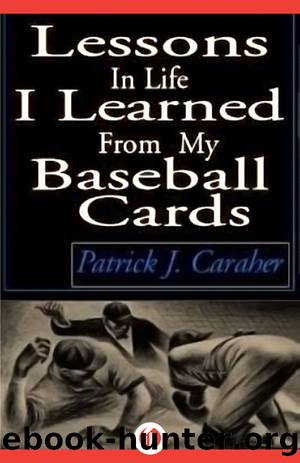Lessons in Life I Learned From My Baseball Cards by Patrick J. Caraher

Author:Patrick J. Caraher
Language: eng
Format: epub
Publisher: Open Road Media
Published: 2002-01-01T00:00:00+00:00
Chapter 9
1977 Reggie Jackson
The Whole is greater than the sum of its parts.
As my interest in baseball matured my focus began to shift from interest in the success of individual players to interest in successful teams. At the beginning of my career in baseball fandom I faithfully rooted for my home team, the Chicago White Sox. I desperately wanted to see them win the pennant and each new season began with my being certain that this would be the year. Inevitably, every season ended with another team playing in the World Series. After experiencing a few seasons of disappointment I began to search for the components that make up a winning team in the hopes that the White Sox could put these components together for their team. I turned to my baseball cards in search of an answer.
My initial analysis focused on the statistics of players who were members of winning teams. One of baseball's many appeals is that it offers numerous statistics by which one can quantify performance. Like no other sport, telling statistics exist for both offense and defense and players are known for their ability to produce these numbers. On the offensive side I studied batting average, on base percentage and slugging average while on the defensive side I reviewed earned run averages for pitchers and fielding percentages for the rest of the team.
Players first stood out for me by their ability to produce good statistics. Baseball cards were not my only source of information about players for I played several statistics-based baseball simulation board games. These games reinforced the perspective that statistics were important. During the winter and on rainy summer days my friends and I occupied ourselves with these games to the point of playing out entire seasons through them.
These games taught me some of the finer points of baseball. The season would begin with the drafting of teams and I found that the draft was the single most important step to creating a winning team. Putting together the right combination of players was essential. You must balance your offense with players who could get on base and players who could drive them home. You also wanted to balance your pitching staff with a number of left and right handed pitchers who could be brought in to get the âbig out".
Though these games taught me much about the players, they also skewed my perspective. I began to think that, like my games, putting together a winning team was simply a matter of gathering the right combination of people who produced good statistics. I was not alone in this assumption. Owners of baseball teams appeared to feel the same way.
In the late 1970s, with the advent of free agency, owners were presented with the opportunity to simply purchase the best team. Several owners opened up their wallets with George Steinbrenner of the New York Yankees being the most highly visible. Although the Yankees had some initial success in the late 1970s, the majority of players on these successful Yankee teams were not acquired through free agency.
Download
This site does not store any files on its server. We only index and link to content provided by other sites. Please contact the content providers to delete copyright contents if any and email us, we'll remove relevant links or contents immediately.
The Ultimate Backcountry Survival Manual by Aram Von Benedikt; Editors of Outdoor Life;(2975)
Never by Ken Follett(2883)
Liar's Poker by Michael Lewis(2812)
Machine Learning at Scale with H2O by Gregory Keys | David Whiting(2293)
Will by Will Smith(2043)
The Partner by John Grisham(1983)
Taste by Kris Bryant(1615)
Friends, Lovers, and the Big Terrible Thing by Matthew Perry(1330)
The Arm by Jeff Passan(1303)
A Short History of War by Jeremy Black(1300)
The Dodgers by Schiavone Michael;(1299)
HBR's 10 Must Reads 2022 by Harvard Business Review(1256)
Can't Hurt Me: Master Your Mind and Defy the Odds - Clean Edition by David Goggins(1227)
515945210 by Unknown(1209)
The Yogi Book by Yogi Berra(1200)
1942266391 (N) by Monte Francis(1174)
Road Games by Road Games(1130)
Moneyball by Michael Lewis(1102)
This Family Does It by Kevin Sellers(1080)
